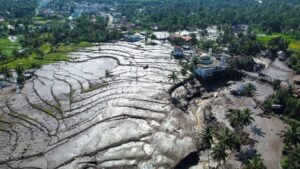What is cool lava, and how did it cause disaster in Indonesia, killing more than forty people?
Because of chemical processes occurring within the volcanic material, cold lava maintains its core heat, but its exterior and behavior are more like wet concrete.
Around 100 homes and buildings have been destroyed in western Sumatra, Indonesia, as a result of intense rain and volcanic activity. Locally referred to as the “Mountain of Fire,” Mount Marapi released a torrent of mudslides, floods, and frigid lava, resulting in a devastating calamity that has left over 40 people dead and several others unaccounted for.
Four areas close to the base of Mount Marapi were affected by the calamity, which was caused by excessive monsoon rains that overflowed river banks and turned otherwise serene landscapes into dangerous floods of icy mud and lava.
What is Cold Lava?

Cold lava, or “lahar,” dropped quickly from Mount Marapi, like a dangerous torrent of wet concrete, destroying everything in its path. According to the United States Geological Survey, frozen lava can be more destructive than molten lava, burying and crushing anything it comes across with unrelenting fury.
Unlike the blazing rivers of molten lava that erupt during volcanic eruptions, cool lava is a mixture of volcanic material, debris, and water that acts more like a fast-moving landslide. This phenomena happens when water combines with volcanic ash and debris on a volcano’s slopes, forming a thick combination that rushes downward with unexpected speed and devastating strength.
The phrase “cold lava” is slightly deceptive because it refers to a material that has cooled down, similar to solidified lava. Cold lava is really heated within owing to chemical processes within the volcanic material, although its exterior look and behaviour are more comparable to wet concrete.
This streaming mass can move far from the volcano’s top, propelled by gravity and the sheer volume of material released after an eruption or strong rains.
One of the distinguishing features of cool lava is its propensity to collect extra debris and silt as it moves downward. This combination may swiftly develop in volume and destructive capability, shifting from a seemingly harmless flow into a formidable force capable of annihilating everything in its path.
Cold lava’s rapid speed and unpredictability make it especially harmful to adjacent communities, since it has the potential to overwhelm settlements and infrastructure quickly.
The US Geological Survey (USGS) has conducted studies that have emphasized the specific hazards posed by cold lava. Unlike regular lava flows, which move slowly and give populations time to leave, cold lava can move quickly, burying or crushing anything in its path.
Because of its high density and abrasive nature, it has the potential to cause substantial damage to buildings, bridges, and roadways, endangering human life and property.
Indonesia, with its many active volcanoes, has seen firsthand the deadly force of cool lava. Mount Marapi, which is 9,485 feet above sea level, has been a source of concern because of its regular eruptions and lahars.
This latest tragedy comes after Mount Marapi erupted in December 2023, blanketing the air with volcanic ash and serving as a terrible foreshadowing to the recent disaster. Rescue activities are underway to discover survivors among the ruins.